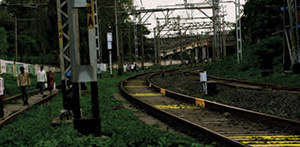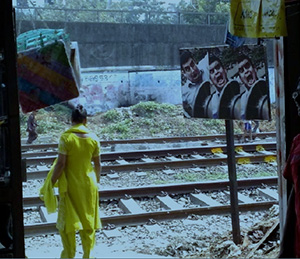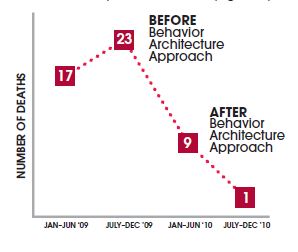The “Great SBCC Example” below was featured during the Designing the Future of Nutrition Social and Behavior Change Communication Conference and can be used as a learning aid or as an illustration of key concepts from country-level experts attending the conference.


Background
Mumbai’s suburban railroads serve over seven million daily commuters; with 2,000 train lines spread over 465,000 km. Besides serving as rail service infrastructure, the railroad tracks are often the shortest pedestrian route between common destinations. With few effective physical barriers and over 1,000 trespassing points, the rail service experiences over 36,000 fatalities per year. Final Mile was engaged to design solutions to reduce fatalities.
Description of Intervention
A behavior architectural approach was taken to reduce unsafe behaviors around the trains. New signs were produced consisting of dramatic photos without text and placed close to the tracks (to increase emotional impact of signs). Train engineers were instructed to hit the horn with short, staccato bursts a certain distance from crossing points (because people pay attention to intermittent noises more than constant noises). Finally, yellow lines were painted at regular intervals on the tracks (because people are bad at judging train speed and distance from the viewer without reference points).
Design Process
Final Mile conducted qualitative research asking people in the target population to identify “other people’s” risky behavior and motivations. Participants spoke of “others’” habitual practices in crossing train tracks or using the tracks to relieve themselves, and routinely expressed overconfidence in their own ability to judge train speed. Their responses also implied an attitude of “private optimism,” that train accidents are things that happen to other people.
Design Constraints

- The intervention needed to be scalable, feasible, and sustainable.
- Implementation could not interrupt train service.
- Communication materials had to be understood by low literacy and multi-lingual pedestrians.
- The intervention could not include overt sanctions or acknowledgments.
Design Strategies
The following findings and concepts were used to underpin intervention design:
- Habits are non-conscious and routine
- Behavioral economics principles helped identify participants’ private optimism (underestimating their risk of train accidents)
- Neuroscience helped identify how the human brain underestimates the speed of large moving objects
Implementation Strategies
- Build in project team diversity across designers, behavioral science, business managers, and architects.
- Redesign signage to resonate with a feeling of fear (previous signage had no emotional transfer) and warn the overconfident trespasser at the right time (see photos).
- Utilize non-conscious design and the ways it influences behavior so that the individual is not consciously aware of the connection between stimulus (design artifact) and behavioral shift.
Evidence of Effectiveness
Within six months of implementation, the number of deaths fell and was sustained over the next year and a half (Figure 1).
Key Takeaways for Nutrition Social and Behavior Change Communication
Figure 1. Number of deaths by month

- Observations become powerful and useful if examined through scientific frameworks.
- Integrating behavioral economics and cognitive neuroscience with design helps to design for the non-conscious. This helps change habits and overcome the cognitive biases and mental shortcuts that all people use.
- It’s important to understand audiences' decision-making. Consider such behavioral economic concepts as mental accounts, temporal discounting, and private optimism.
- Build in project team diversity.
- Clearly understand and respect programming constraints.
- High science can equal high impact without high cost.
Organization: Final Mile
Final Mile is a behavioral architecture agency that explains and influences behavior to meet marketing, organizational, and social objectives by applying learning from cognitive neuroscience and behavioral economics.